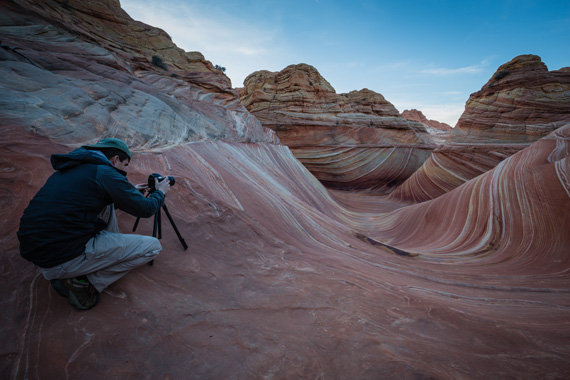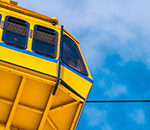These days, everyone’s a photographer, from the studio owner shooting weddings on the weekends, to your cousin with an iPhone. Cameras are more widely available now than ever before, and many people are discovering a love for photography. Some even choose to pursue it as a career, taking on photography courses or a full degree in the subject. Whether you’re a serious student, an accomplished artist, or a hobbyist, there is much to learn from these icons of photography, both from today and years past.

1. Alfred Stieglitz: Alfred Stieglitz is known as the patron saint of straight photography, pioneering the idea that a photo should be about the subject, moment, and artist’s vision rather than a contrived manipulation. In Stieglitz’ time, photography was not considered much of an art form, but this artist worked passionately to ensure that his photographs had as much or more artistic expression as a traditional artist’s work. In today’s age of styled shoots and Photoshop, studying his approach to photography offers a refreshing look into photography as artistic expression.
2. Ansel Adams: Of all the photographers on this list, Ansel Adams is perhaps the most widely recognized, and for a good reason. His photographs of the American West, particularly Yosemite National Park, are iconic and beloved. In addition to his impressive body of work, Ansel Adams left his mark on photography by developing the Zone System. This system was a way to determine proper exposure and contrast in the final print, and it resulted in intense clarity and depth, as evidenced by his photographs. His intense commitment to quality is inspiring to photography students.
3. Diane Arbus: Norman Mailer said, “Giving a camera to Diane Arbus is like putting a live grenade in the hands of a child.” Her photographs are shocking, catching subjects in an unmasked moment, whether they were of famous writers and actors or transvestites. In this style, Arbus teaches a lesson about not aiming to capture the surface of a subject, but rather, working to reveal the subject’s true self through art.
4. Louis-Jacques-Mande Daguerre: Lovers of photographic prints owe a debt of gratitude to Daguerre. Although he was a Romantic painter, printmaker, and inventor of the Diorama, Daguerre’s most monumental contribution to society is the daguerreotype, the world’s first reliable process of creating a permanent photo. Using light and chemistry, Daguerre created photographic images on silver-plated sheets of copper that are the ancestors of today’s photographs.
5. Phillipe Halsman: Philippe Halsman is best known for his jumping photographs of famous subjects from the middle of the 20th century, from Richard Nixon to the Duke and Duchess of Windsor. Halsman’s body of work also includes surreal portraits of the artist Salvador Dali that leave the viewer puzzled and trying to figure out how the photograph was physically possible. Any photography student who is interested in pushing the envelope with portraits should study Phillipe Halsman’s portraiture.
6. David LaChapelle: Although many iconic photographers are from centuries and decades past, David LaChapelle is a fine art photographer currently working today. He offers photography students inspiration for creating their own strong and individualistic photography. In his work, you will see bold, surreal examples that highlight an understanding of social and political issues with a sense of humor.
7. Sally Mann: Another actively working photographer, Sally Mann is just in the middle of her career. She was named America’s Best Photographer by Time magazine in 2001 for her stunning work of her family, as well as southern landscapes and her series of decomposing bodies. Her work has pushed buttons, from nude photographs of her children to rotting corpses, and she likes it that way. Students can study her work to see how it’s possible to keep a consistent style and vision, even when working with subjects that are completely unlike one another.
8. Jerry Uelsmann: Jerry Uelsmann believed that using a camera allowed him to exist in a world outside of himself, in the work that he captured. The world in Uelsmann’s photographs looks much different than the one we live in, as he created composite photographs depicting surrealist images. With a digital camera and Photoshop, photographers today might be able to create similar work with relative ease. But Uelsmann did it before Photoshop, using multiple negatives, enlargers, and extensive darkroom work to create his work, bucking the idea that a final image could be composed from many negatives. His commitment to doing something extensively different is an inspiration to today’s photography students.
9. Jacques Henri Lartigue: Lartigue began taking photos at the age of 7, documenting his friends, family, and the world around him. He is known as the father of modern photography, and the first “amateur” photographer. Photography students can learn the pure joy of photography from this unsuspecting artist. He lived most of his life as an amateur photographer, not even knowing how remarkable his work was until his childhood photographs were discovered and exhibited at the Museum of Modern Art in New York at the age of 69.
10. Elliot Erwitt: Photography students interested in a lifestyle or photojournalistic approach to photos will enjoy studying Elliot Erwitt’s life and work. He is the purveyor of the “non-photograph,” taking a casual approach that unveils a true portrait of his subjects, whether they are dogs or Marilyn Monroe. Study his work to learn about the beauty of casual and uncontrollable photography.
About the Author
I’m Adam Park, a freelance writer and blogger. I regularly contribute to the http://www.bachelorsdegreeonline.com/blog/, which discusses about education, students life, college life, career and History. Particularly love to connect with my readers. Please be open to send me your questions comments or any suggestion to: park.adam2@gmail.com.
Like This Article?
Don't Miss The Next One!
Join over 100,000 photographers of all experience levels who receive our free photography tips and articles to stay current:





it is very good really enjoyed reafing get better soon
You forgot one who definitely needs to be included. His name is Blake Rudis. You can find him at http://f64academy.com/.
Outstanding photog and Photoshop expert.
My 2 cents: The photojournalism work of W. Eugene Smith makes you stare at his work forever and makes you pick up the camera. Those unfamiliar with his work should google his name and then go to images.
I think for me you have a very interesting list and some of the names people are mentioning are great photographers as well. The one guy that has taken some of the best images in black and white would be the late great Gordon Parks.
Dates of birth and death need to be given in your listings for some historical perspective. Thanks for your verve and opinions.
Gene Smith
Cornell Capa
Lartigue
Bruce Davidson
and, of course, Dick Swift
This is a top ten list so of course not all of your favorites could be placed on the list. But you all mentioned some great photographers.
David LaChappelle and Dagerre are probably two of the most famous on this list. The others, I have heard their names mentioned here and there. Thank you very much for this list, I will look all of them up for sure, many of them have taken award winning pictures and have gone on to have very successful careers in photography.
Eric | https://myschoolpicture.com/student-portraits.html
thank you for the list im doing a school project
It’s enlightening meeting the creme de la creme of this foto bizness. I really hope i will also be remembered for something in this field
sally mann? while she’s a very good photographer, she’s not the pioneer of shock photography. jock sturges is the one. cartier-bresson, avedon are two of great photogs that should be studied by every photographer as well.
The author has not said why we should study these photographers. I want to know what it is about each photographer that is different enough and what I can learn from studying them that would warrant being on this list.. As mentioned by others there are many others who are worthy of study; although some posters have confused the reason for this list and put up suggestions of people who, are just favourites rather than those who are worth studying. There also a few photographyers worthy of study who are not even known to the average photographer also may deserve to be studied.
the picture appear is not own by the listed photographers…
Niepce? Atget? Bresson? Robert Frank? Friendlander? Winogrand? PL diCorica? Bernd and Hilla Becher? Henry fox Talbot? Robert Adams? Lewis Baltz? Henry Wessel Jr? Man I could keep going. You have some good names on the list but only a few of the greats.
My favorite photographer ever is Henri Cartier-Bresson. The father of the “decisive moment”.
I dislike these types of lists and I’d not be the only one.
As others have pointed out there are gaping holes in it; Cartier-Bresson, Tony Ray-Jones, William Klein, Robert Frank, Martin Parr, Bruce Gilden, Andreas Gursky, Michael Kenna, Rankin, Garry Winogrand, Friedlander, Bill Brandt etc etc etc etc and a big bunch of others I’ve forgotten !
Plus, it contains in it one of my most disliked words….. ‘should’ !
wonderful list, and some of the comments add a few nice additions. i’m really glad it doesn’t include any of the folks we’re already bombarded with online.
annie leibovitz certainly belongs on this list as well.
strange to not include Kertesz Andre, Capa,even Brassai …
then my question is: what was the criteria based on which you selected these 10 photographers?
Concuerdo con Shauna… faltó Cartier Bresson y Avedon, pero muy buena selección de todas formas…
Saludos!
It’s Elliott Erwitt, not Elliot Erwitt.
My God! How could you leave Arnold Newman off the list? The father of environmental portraiture.
No Henri Cartier-Bresson, No Robert Capa, No Steve McCurry, No Raghu Rai…’: (
Another famous photographer who should be on the list: Yousuf Karsh.
http://karsh.org/#/the_man/home/
I’m surprised you left Avedon and Bresson off this list. They are a must in my opinion.
What a great list! I was fascinated, however, by your decision to leave off Henri Cartier-Bresson. No complaint, merely an observation..
If you haven’t read about this photographer yet, you should. Amazing work and street photography.
This was created in dedication to the photographer Vivian Maier, a street photographer from the 1950s – 1990s. Vivian’s work was discovered at an auction here in Chicago where she resided most of her life. Her discovered work includes over 100,000 mostly medium format negatives, thousands of prints, and countless undeveloped rolls of film.
http://vivianmaier.blogspot.com/